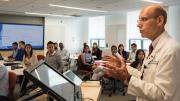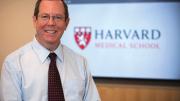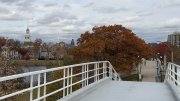Harvard Medical School (HMS) is reforming its four-year curriculum structurally, pedagogically, and philosophically. The new curriculum, which builds on the New Pathway curricular reform of 1987 and an iterative update in 2006 called the New Integrated Curriculum, further emphasizes the process of learning to learn, rather than rote memorization, and represents one of the most complete curricular reforms at a U.S. medical school since the scathing Flexner Report of 1910 led to the closure of many medical schools in the country.
As dean for medical education Edward Hundert explains, ever since the Flexner Report put an end to for-profit schools that relied solely on apprenticeship to transmit knowledge from one generation of physicians to the next, medical schools have operated largely on what is called a “two plus two model.” It begins with two years focused on basic science taught in the classroom; students have some patient exposure but are mainly involved in patient care only during the second half of their schooling. Nationally, all of this is changing. Some medical schools have moved the hospital clerkships into the first two years, and some have shifted to team-based learning, or to flipped classrooms in which students absorb material on their own time by watching videos; a number of schools have also asked their students to complete a scholarly research project after their clerkship year, says Hundert. But HMS is unusual in that “We’re making all of these changes at once, and in an amazingly integrated way.”

Dean for medical education Edward Hundert
Photograph by Stu Rosner
The changes, the result of a three-year, faculty-led process, were deemed necessary at least in part because both biomedical science and the practice of medicine itself are changing rapidly. Hundert tells arriving students that “half of what we teach you during four years of medical school is going to turn out to be wrong or irrelevant by the time you graduate.” Or as Gordon professor of medical education Richard Schwartzstein puts it, “Facts are necessary, but they are not sufficient. And there are too many facts for everybody to learn anyhow, so let’s get away from this notion that you could possibly learn them all, even if you wanted to.”
The institution of a scholarly research requirement, beginning with the class of 2015, created the opportunity for students to work closely with a faculty member in a focused area of interest, but under the two plus two model, the research took place during the summer after the first year. This timing meant students had to choose a project mentor just months after arriving on campus, says Keenan Mahan, president of the class of 2018 and president of the HMS and Harvard School of Dental Medicine (HSDM) Student Council. “It felt a lot like speed dating.”
Mahan, a member of the last class under the old curriculum, says that some of his peers are involved in their summer internship now, but others haven’t been able even to start them because of Institutional Review Board (IRB) deliberations over research involving human subjects. By the time his classmates write up their research projects in their third or fourth year, their biomedical interests may have turned elsewhere. In the new curriculum, the project will start at the end of the third year and continue into the fourth. All the students Mahan has talked to think this shift is “excellent.” (The exception to the new curriculum: the 30 or so students enrolled annually in the Health Sciences & Technology program jointly run with MIT will continue in the two plus two format, enhanced with other innovations designed for physician-scientist training.)
With the previous course of study, Schwartzstein says, faculty leaders observed a “perception among students that the curriculum was mostly about memorization of facts, as opposed to development of reasoning and thinking skills. We had a sense that students were learning differently and were resistant to the lecture format: instead of coming to class, they would watch video of lectures at double speed. Showing up wasn’t adding value relative to watching at home. The answer to that is not to compel them by various means to come to lecture. It’s to rethink how we add value to the learning process.”
Given that “student-faculty contact time is the most precious resource you have in the University,” Schwartzstein continues, “we have to make the best use of that time. The way I sum that up: that time needs to be spent on things that you can’t Google.”
From Classroom to Clinic
The new curriculum therefore gets away from lectures. Called “Pathways” (not to be confused with the “New Pathway” curricular reform of 1987 that introduced problem-based learning in the first two years), it begins with an intensive, 14-month pre-clerkship program, designed to give students the core medical knowledge they will need to work in hospitals. Students acquire critical knowledge before class through modular faculty-developed “concept videos,” each roughly five to eight minutes in length, in addition to assigned readings and questions to investigate. Class time is used to develop the thinking and reasoning skills needed to solve difficult problems; teams of four or six students are assigned to share their findings with the rest of their 40-plus-person class in a discussion that generates a consensus answer.
Four mornings a week, students grapple with a variety of biomedical subjects, such as genetics, anatomy, pharmacology, pathology, and immunology. All day Wednesday, they take “Practice of Medicine,” co-led by assistant professor of medicine Fidencio Saldana, which is designed to give them hands-on skills for working with patients, such as conducting an oral interview and performing a physical exam. As part of this pre-clinical preparation, students will spend every other Wednesday morning working in a primary-care office. One advantage of introducing students to work in medical settings right away, says Saldana, is that it leads to “better integration of the basic, social, and clinical sciences.” That way, students will “have context for everything they are learning in class,” and be well-prepared for their clerkships.
That “principal clerkship experience,” in which students enter hospitals to begin working with patients on the wards, will now begin in October of their second HMS year. Planners reasoned that they should put students in contact with what they love—working with patients—as soon as possible. And to maintain continuity with patients and doctors they have come to know, students will continue to spend a half-day every other week in the same primary-care office where they worked the year before.
By the time students return to the classroom for their third and fourth years, they will have a better idea of what they want to do next, says McKenzie professor of cell biology Randall King, an active researcher who serves on the academic planning committee. The curricular change “will allow students to develop their clinical interests earlier, which will help them in thinking about residencies. Pedagogically, they will be in a position now to really take advantage of the richness and the depth that the medical school has to offer”—basic scientists and clinicians working in many different fields. “By allowing students to tailor their post-clerkship curriculum a bit more,” he adds, “we think these advanced courses will become a place where students can meet with faculty in more of a seminar-type format and really pursue” cutting-edge questions.
From the faculty perspective, and “as a person running a lab,” King continues, “the real opportunity is to get our basic-science faculty engaged in the teaching of medical students, because they can teach in a way that integrates with clinicians. I could get involved,” for example, “in co-teaching a session on novel cancer therapies together with an oncologist.”
Teaching Thinking
The re-ordering of the course of study is important, says Schwartzstein, “but a lot of curricular reform is like shifting the chairs on the Titanic. The essence of this reform is giving students the tools to think differently. The challenge is going to be: How do I now work with [my factual knowledge]”—most of which students will learn on their own—“to solve clinical problems? Because that’s the task of a doctor.”
For this reason, CBCL—case-based collaborative learning—will now be at the core of first-year classes. Schwartzstein describes it as a combination of case-based, team-based, and problem-based learning—all recently tested in a physiology course. “What we’re trying to do,” he says, “is take elements of all three of those teaching formats and blend them together” for use in the pre-clerkship-year courses. In a randomized study of the new teaching technique (forthcoming in Academic Medicine), students perceived CBCL as more engaging and interactive, he reports, and students who’d done relatively poorly in earlier courses did better compared to the control group. There were no differences in outcomes for “high performers,” he says, “but it didn’t hurt them.”
Adds Hundert, “Since medicine is practiced in teams, we’re trying to start that from the beginning. You have responsibility for your peers’ learning, the same way you’re going to have shared responsibility for patients. And we are simultaneously reinvigorating our advising system to help students take advantage of the tailored ‘Pathways’ through their third and fourth years.”

A damp lab, with multi-user microscopes, in one of the four new “learning suites” in the school’s Tosteson Medical Education Center
Photograph by Stu Rosner
Assessment and improvement of the new curriculum will be continuous. A two-year grant from the Harvard Initiative for Learning and Teaching will enable a comparison of the last class in the old curriculum to the first class under the new one. “In a sense, I feel like the deck is stacked against [the reform], because the first year of the new curriculum is going to be challenging for a whole bunch of reasons,” Schwartzstein says. “Nonetheless, we’re making efforts to study it and improve it, and will continue to study it; we’re committed to this notion of evidence-based curriculum development and revision.”
Hundert concurs that he doesn’t expect everything to work perfectly from the start, even though “faculty have spent hundreds of hours preparing each hour of the curriculum. We’ve partnered with a student group called the Medical Student Medical Education Interest Group…to make sure that in real time, the students will be giving constant feedback to faculty, who will be doing continuous improvement as we go—not just saying, ‘We’ll fix that next year,’ but ‘We’ll fix this next session and next week.’”
Longer-term, Schwartzstein hopes the curriculum will be organized to address questions that need to be answered, rather than merely to present a body of knowledge. And he hopes to teach students to think about how they are thinking. “We have to help teach our students not only how to reason, but how to avoid the pitfalls associated with cognitive biases,” he emphasizes—because relying on intuition or pattern recognition may cause errors in clinical practice (see “Toward Precision Medicine,” May-June, page 17).
The Reform Embodied
On August 3, the first day of orientation for the HMS class of 2019, students immediately got a taste of case-based collaborative learning, working in teams of four to reason their way to explanations for a difficult clinical situation—all in brand-new classrooms equipped to facilitate learning under the new curriculum. In the Tosteson Medical Education Center, 10,800 square feet of space has been renovated this summer at a cost of $5 million to create four new “learning suites,” each equipped with three different types of rooms. The largest room is designed to support interactive group learning. An adjacent “damp lab” features multi-user microscopes where students can work with human tissue or anatomical specimens. The third connected room in each suite supports the use of patient simulators that allow students to see what happens to blood pressure, for example, when they administer a particular drug.
Developing the best curriculum possible matters, says HMS dean Jeffrey Flier, because the school is seen as a model elsewhere: “We know we are not just doing it for ourselves. We also have some responsibility for how it will be seen and possibly reflected in many other schools.”
The ultimate test of the new curriculum, says Schwartzstein, will be whether students “learn how to work with principles that are evolving, and knowledge that continues to grow and expand, so that they’ll be able to function at a high level throughout their entire careers.” Concludes Hundert, “Medical education is not about the transmission of information, but about the transformation of the learner. In order to achieve that, you need a transformative learning environment, and that’s what we’re trying to do both with the physical spaces, but also with the way the curriculum is structured and taught.”












